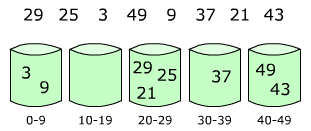User:Earlster/Sandbox
 Example of insertion sort sorting a list of random numbers. | |
| Class | Sorting algorithm |
|---|---|
| Data structure | Array |
| Worst-case performance | |
| Best-case performance | |
| Average performance | |
| Worst-case space complexity | total, |


Proxmap Sorting, or Proxmap, is a sorting algorithm that works by partitioning an array of data items, or keys, into a number of buckets. If keys are "well distributed" among the buckets, sorting occurs in time, much faster than comparison-based sorting that can do no better than . During generation a proxmap is created, which is used to find keys in an average of time. This algorithm also scales up.
Keys are dropped into each bucket using insertion sort. Since bucket sort is not a comparison sort, the Ω(n log n) lower bound is inapplicable. The computational complexity estimates involve the number of buckets and the key used.
Overview
Proxmap works as follows:
- Initialize: Create and initialize 4 arrays
- Process: Using a carefully chosen key function, come with a series of "buckets" using the arrays
- Drop: Go over the original array, dropping each object into its bucket, insertion sorting as needed.
- Collect: Visit the buckets in order and put all elements back into the original array.
Example
Consider a full array: A[0 to n-1] with n keys. Let i be an index of A. Sort A's keys into array A2 of equal size.
| 1 | 1 | 2 | 3 |
|---|---|---|---|
| 2 | 2 | 4 | 6 |
| 3 | 3 | 6 | 9 |
| 4 | 4 | 8 | 12 |
| 5 | 5 | 10 | 15 |
Pseudocode
function proxmap-sort(array, mapKey) is
hitCount ← new array of size n
location ← new array of size n
proxmap ← new array of size n
sortedArray ← sorted array of size n
for i = 0 to (length(array)-1) do
insert array[i] into buckets[keyFunction(array[i], k)]
for i = 0 to n - 1 do
next-sort(buckets[i])
return the concatenation of buckets[0], ..., buckets[n-1]
Here array is the array to be sorted and n is the number of buckets to use. The key function such as keyFunction(x,k) returns the k most significant bits of x (floor(x/2^(size(x)-k))); different functions can be used to translate the range of elements in array to n buckets, such as translating the letters A–Z to 0–25 or returning the first character (0–255) for sorting strings. Another method could simply take the floor of the incoming data divided by 10, or floor(k/10) Buckets get sorted as the data comes in, not all at the end.
Optimizations
Many optimizations include using the same array to store the sorted data, reusing the hitCount, proxMap, and location arrays used to sort the data. To be expanded on later...
Generic bucket sort related to Proxmap
The most common variant of bucket sort operates on a list of n numeric inputs between zero and some maximum value M and divides the value range into n buckets each of size M/n. If each bucket is sorted using insertion sort, the sort can be shown to run in expected linear time (where the average is taken over all possible inputs).[1] However, the performance of this sort degrades with clustering; if many values occur close together, they will all fall into a single bucket and be sorted slowly. This holds a similar story with Proxmap, if the buckets are too large or too small then the performance of the function degrades severely.
Comparison with other sorting algorithms
Generally, it works relatively fast when compared with other sorting algorithms as its not comparison-based. The function is nearly constant access time which makes it very appealing for large databases. Despite the O(n) build time, it makes up for it with its O(1.5) average access time. If the array doesn't need to be updated often, the access time makes this function more favorable.
References
- ^ Thomas H. Cormen, Charles E. Leiserson, Ronald L. Rivest, and Clifford Stein. Introduction to Algorithms, Second Edition. MIT Press and McGraw-Hill, 2001. ISBN 0-262-03293-7. Section 8.4: Bucket sort, pp.174–177.
- Thomas A. Standish "Using O(n) ProxmapSort and O(1) ProxmapSearch to Motivate CS2 Students (Part I)" from Donald Bren School of Information and Computer Sciences at UC Irvine.
- Norman Jacobson "A Synopsis of ProxmapSort & ProxmapSearch" from Donald Bren School of Information and Computer Sciences at UC Irvine.
External links




